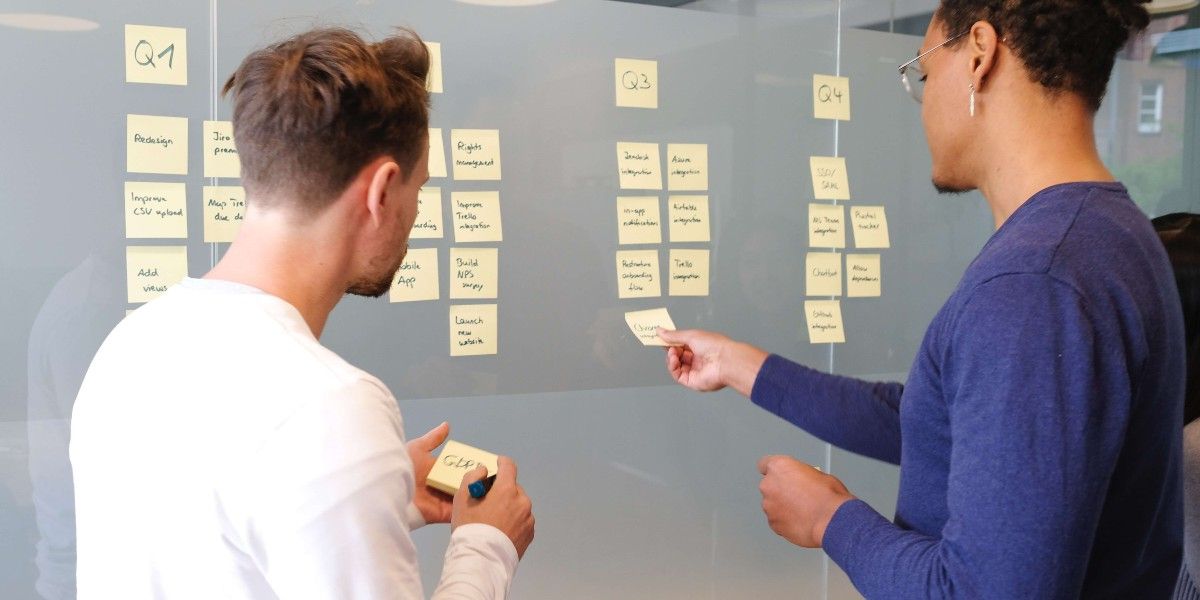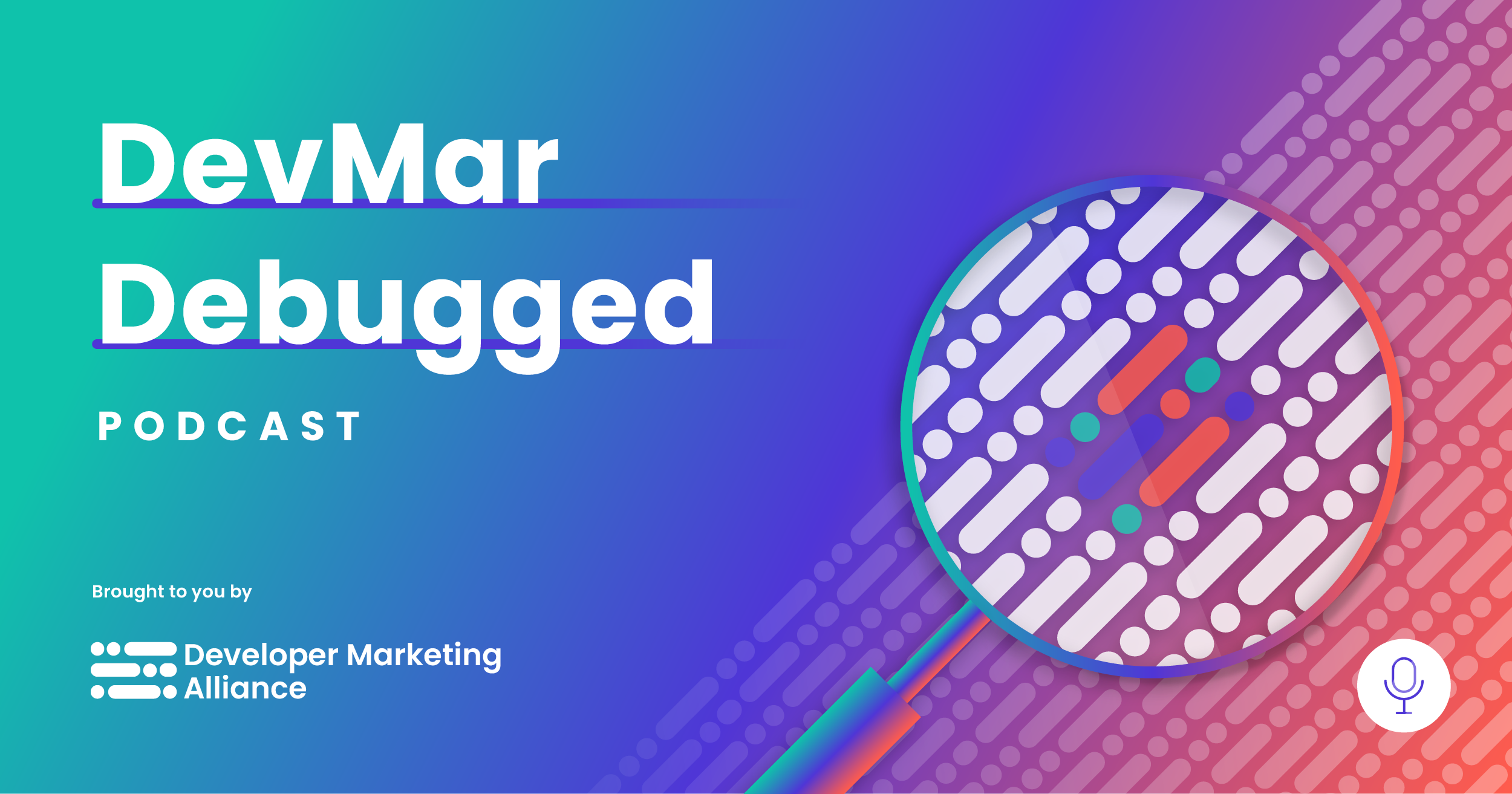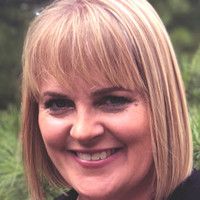NB: This article is based on a talk given by Stacey Kruczek, who, until very recently, was still Senior Global Marketing Leader of Developer Relations at Zebra Technologies.
At the 2022 Developer Marketing Summit in San Francisco, Stacey Kruczek, Director of Developer Relations at Aerospike, talked about her time at Zebra Technologies.
- Who Zebra Technologies is and what they do,
- Why Zebra Technologies was in need of a robust developer marketing strategy,
- The importance of defining different developer personas when implementing your strategy,
- How Stacey was able to make significant improvements to Zebra’s developer marketing toolbox,
- What Zebra’s developer marketing toolbox looks like today.
You can read the highlights from Stacey’s presentation below.👇
Who is Zebra Technologies, and what do they do?
I started with Zebra Technologies almost seven years ago now as a Technical Marketing Writer. I was interviewed by the DevRel team for engineers in our specialty printing group, SPG, and a DevRel lead.
They needed somebody to come in and help them tune up their content, work with some of their editing tools, and help them deliver consistent content to their community.
What I thought I was going to be doing on day one quickly evolved into that 30, 60, and 90-day plan that we all have to put together. I was truly ambitious when I put those things together, so it quickly evolved within 30 to 50 days.
When I came into the company, they were merging Zebra Legacy with Motorola. Imagine you're going into Target and you're making a return. We have a mobile device that scans the barcode on your phone. Those are our scanners. They're printing out things or looking for inventory throughout their technology and location services.
So, that's what we started with until we merged with Motorola and their enterprise mobile computing. Now, we've got all these mobile computing devices, so we’re a force to be reckoned with on the hardware side.
Our developer community was really internal and external when I walked in. We started at about 5,000, went up to 7,000 people, and now we're close to 10,000. We just keep going out and gobbling them up.
We're also in the software space and we're definitely making a mark on it in robotics, machine vision, you name it. We're stretched thin in our DevRel team, but it's an exciting time at Zebra because we're expanding so quickly.

I’ve spent over 25 years in marketing. I've dabbled in technology and some development and databases and things of that nature. It's something that I've been doing throughout my entire career, but I've always been on the marketing side because I'm a creator, a builder, and a strategist, and I love to go in and fix things.
Now, Zebra Technologies as a community and our developer community may not necessarily align strategically to your community, but there are some necessary tools you should adopt when talking to developers.
Whether they be enterprise developers or independent developers, whatever those developer personas are, you need to have certain pieces in your toolbox. It just might be different for each company.
I want you to have an idea of the tools we had when I walked in and then what they are today. In the first 60 days, I had to go out and define our developer personas. That was an interesting ride.
Collaboration is key. I walked into an engineering department as a marketing person. Why is a marketing person working with the engineering team? Collaborating with the marketing, product, sales, and channel teams is key and has been key all along.

Then there’s growing awareness and engagement organically. And I'm talking about everything: content, social, you name it. We'll talk a little bit about how I carry a tin cup and go to all the product areas and beg for money to put towards our developer portal and some of our tools.
Understanding the importance has quickly evolved now, and we have the attention of the organization for several reasons.
One of the other things I want you to walk away with is making use of use cases. This is incredibly important. What have you built as a company with developers, ISVs (independent software vendors), or your ISVs and their development teams that you can teach and tell your developer community about?
This has been one of the key components of the content that we're driving to our developer community.

Why Zebra Technologies needed a robust developer marketing strategy
So there I was in the hot seat in the first 30 days. And this was fine, I could totally handle it. I quickly learned where all our content was, and it was like this octopus of information.
We had our TechDocs that were being managed somewhere out in New York. Technical documentation, white papers that held a lot of interesting, rich technical content. Then we've also got our blog.
We have a developer advocate team. We have three engineers that work with me directly, but they're mainly print engineers. Then we have the enterprise mobile side of our business. We have engineers there that are developer advocates, but that's only 10-20% of their job. Their job really focuses on their product.
So, it was a bit different in terms of how content was being managed and where we were getting it from. So I had to take all that together, put it in hand, and then decide how there would be an editor-in-chief for this and how we were going to reflect the right voice in our community.
During the first 30 days, it quickly became clear that we could work on so much more, which is why I offered to create a developer strategy. Hence, I'm a developer marketer.
So I was sitting in the sea of engineers and I was challenged with understanding what the developer community needed to be doing. And so, I took the time to evaluate their current toolbox.

There were some things that were working that they were doing as a small team. They had a developer portal that had good information. It wasn't beautiful, but it didn't have to be.
Did it get the developer the information and technical content they needed? Yes. Were we answering their questions in the forums? Yes. Did we have experts that were helping? Yes.
In terms of our developer events, when I walked in they had these monthly dev talk webinars on certain pieces of information for the developer community. And we brought in our product experts, some of our own internal engineers, and our extended dev advocate team to conduct these one-hour webinars.
We had about 50-150 people sign up to these developer talks, and about half of those would actually attend, then they'd watch it on our YouTube playlist. Our mailing list at that time on Mailchimp was about 2,000 people, and within two years I headed it up to 5,000. Today I have it up to 21,000.
We know that dev docs and tech docs are important pieces of information. They told us back then and they're still telling us now that they want this information. There’s still a separate site that’s handled out in New York and I’ve got another team managing it. There’s good information there, but it's disjointed.
Then we have our Developer Kitchens, which involve meetups, workshops, and mini-hacks. But for Zebra, it's unique in that we work really closely with our independent software vendors and our internal teams, and they go out and find the developer teams to bring in.
So we might have new technology or something that we want to teach them, such as how they can build on our mobile devices and use our enterprise browser, which is one of our trademarks. We'll bring in about 20-30 people and give them beer, pizza, and some swag. We’ll then say, “Alright, let's go develop,” and then we create these use cases.

We had a social presence on Twitter and LinkedIn which was working but it wasn't great, and the corporate social gods were saying, “We want to know your engagement metrics and your click-through rate. It's about quality, not quantity. That's what I started professing with them in 2018.
We had a Zebra developer community group on the side that worked very well. We had that up until last month when I converted it to what is now a public company page where we're sharing information and cross-promoting. We weren't doing that before.
The thing that really drove me crazy about the socials is that they lived on the social team. So if I wanted to publish a tweet, I had to put together the content, have that team edit it, go through it, and get the stakeholder sign off. Two weeks later, I eventually got a tweet.
The coolest thing about being on that team is that I learned a ton from these engineers, even development. Involve me and I learn. This is what we have to remember when talking to our developer community. It's how they interact with us.

The importance of defining different developer personas
When defining the personas, I had to look at the developer ecosystem. Who are the developers? We know we need to cultivate and nurture that developer ecosystem; it can absolutely help your company accelerate in terms of innovation and developing new features and offerings much more than companies that don’t cultivate these ecosystems.
I thought it was a great philosophy and I wanted to follow that.
We have to try and balance the short and sweet of the technical content but give it depth, so we looked at the demographics. We could run heat maps on our developer portal and then have reports we could run off Google Analytics. We could also find out where they reside within our company personas. Are they partners, ISVs, customers, or independents?
Then what do they value most? We started asking them in the forums with quick surveys and pop-ups. We soon got data and information from them; they're very vocal.
Where do they find answers to their questions? Our forums are incredibly active and we have 12 dev advocates that are constantly answering questions. Now. we have product teams on there looking at it, reviewing it, and saying, “We’ve got to make a change to this and revise our roadmap.” And now we have the product engineers participating in some of our developer talks.

Do they know who you are? This now became brand. I’d talk to the developers in the community when we’d go out to events and I'd say, “Do you know how to get to us? This is our developer portal.”
And they’d say, “Aren't you Zebra Technologies? I don't know where to go for your developer portal.” And why was this? Because the portal was right down at the bottom of the page. It’s still there today, but we're making some changes.
So, we really didn't have a brand and they really didn't know who Zebra Technologies was. A lot of people said, “Oh, you're that printer and scanner company,” not understanding that we had all these developer tools and opportunities. So we had to change that.
Within that first 50 days, I had to sit down and think about who these personas are, where they reside, and where they live.
So I created this graph that we used for our biannual event called App Form. And developers were sitting within our partners, ISVs, and customers, and they were also independents.
Yes, there are internal developers at Zebra. They're developing applications for an airline that they're going to print off and scan when you check-in. They're working internally. We need to recognize that because so often they wanted to separate it.
And then we had our business innovators. This was important to a lot of our thought leaders to have these. Some of our ISV leads were actually former developers and they wanted to get information from us too.
So I did what I had to do in terms of refining these personas, getting them out and saying, “Now we need to go out and talk to the developer community if we're going to expand this and expand our offerings.”

Implementing improvements to Zebra’s developer marketing toolbox
We knew brand awareness was an issue, but we had the developers looking at our content, considering it, and comparing it to our competitors. They'd evaluate all of it, those metrics, forums, downloading our SDKs, API calls. To that extent, we had to go back and look at that. Are they retaining it, are they building it, and do we have use cases?
I became this person known in the marketing organization as the “why” lady. “Why are we doing this? Why does it take two weeks for us to get a social tweet out? Why are we waiting so long to talk to our product people? Shouldn't our product people be involved with all of this from the beginning?”
I had to ask a lot of different questions and we didn't have a big budget, so I had to think very creatively and out of the box.
So, as a result of this, we needed to make some changes. Our App Forms were conducted in three regions back in 2018 and 2019, APAC, NALA, and EMEA.
In NALA, I had an opportunity to bring in a lot of those personas; that ISV lead who was a former developer, customer developers, and other outside independent developers that I’d met through some of my networking. I had an opportunity to bring them in and create the Dev Council, which we put on Slack.

We've had an opportunity to talk to the Dev Council, but we haven't kept up with it as much as we should have. We've gone through some transition because at that time we also moved our entire DevRel team over to marketing.
What I learned from this Dev Council was that they wanted a DEVBUZZ newsletter. They weren’t paying attention to the partner newsletter and they didn't know where to get the information. We needed to give them technical and developer information from the sources they know, the experts on the portal.
So we created the developer newsletter. We started in NALA, we're using that 21,000 recipient list, and we have metrics that are all above industry standards.
We went through a whole process of creating a developer brand. We use it today, it's working, and people like it. We've also got really cool swag.
Then we wanted to create a better developer experience. That's the feedback that we were hearing. At that point, we were going to roll out some of our software offerings and our data analytics platform, and we were merging all of this information with the developer portal. We had to work together because they were going to have APIs for free as well as ones you had to pay for.

A group that we work with had gone in and originally established our DevRel team back in 2015 before I joined. We asked them to come back in, reevaluate, and go out and talk. This was their process, but I used it for everything.
We used it for the developer portal and for developer marketing. It's about discovering, evaluating, learning, building, engaging, and committing.
When you look at it from a developer portal perspective, they were basically putting it up there and finding out the pain points. Did you find the technical content that you needed? Were you able to navigate the landing page? How did you get there from zebra.com? Tell us your route. So we followed the developer journey and got feedback.
They went to some of our partners, ISVs, customers, and independents, so we were getting very good data that was going to tell us how we had to reevaluate and do our developer experience. That constituted a change.
Collaboration is key, so leveraging those internal teams became so important. I also had to take that developer experience and share that data with them to say, “We need to change the organization. Everybody outside looks at the Zebra developer community, and we need to engage more with them and understand our advocates.”

We had such a wealth of information internally at Zebra. These people are brilliant. They’re going out and talking at events and Android workshops (we're an Android-based company), and they're sharing all this information and content. They have followings, so let's elevate them. There are champions, so let's promote them.
Developers had also shared that they wanted authentic information. Zebra developers especially wanted depth and code examples, use cases, and shared experiences, so we're giving it to them.
We started communicating with many of the ISVs and doing a lot of developer talks on what we're doing with them and how we're creating new opportunities for developers, and then giving them complete information on how to do it themselves.
RFID is a really hot topic right now for us. We talked to a couple of our product engineers about doing a dev talk community day, which is an extended version of a dev talk. It was basically four or five talks on RFID.
Our registrations for the past couple of years on a lot of our developer talks have been about 200-300, maybe 400 if they're really interesting.

We look at the conversion rate and attendance rate for these talks, and then we look at the watch metrics on YouTube. We're seeing that over 52% are attending, so they're absorbing the information and they're on there 90% of the time listening.
Last week we did the RFID day. We had 955 people register, and over 53% of those people actually attended. Our watch metrics have also escalated, so now we're getting the attention of many people.
Remember with social that you need to set the stage. It can play a part, but it's not going to be the lead. We're very fortunate that we have a great new social media manager who gets this.
Are they finding the information? Are they registering for your events? Are they attending? These are the type of metrics and journeys that we need to follow. It can play the part, but it's not the lead. It can deliver the right performance for you and give you the right content.
We're now pushing out a lot of content through video as opposed to blogs because we're seeing the metrics go down on them. People don't have the time to read them.
We're going to elevate our podcasts; we're rebranding and revamping them, and we're going to put those out. There’s also going to be more vlogs. We're prepping that right now for some good use cases.

You have to constantly be measuring to see how you're progressing. And I've been able to do this over a seven-year period. I've been very blessed that I've been able to be here to see its success.
What does Zebra’s developer marketing toolbox look like today?
We have our developer portal and our blogs on that portal. We're still getting contributions from our product engineers and dev advocates. There are a lot of people that want to write blogs for our portal.
We're also revamping the entire developer experience based on data from three years ago. I'm finally getting to do it today, and guess what? TechDocs is going to be part of that. I'm really excited.
We have our dev talks, which are the most important thing we do, and it's the best way to reach our community. We have our Dev Kitchens meetups and we're doing more this year.
We're revamping our podcasts and our events. We rebranded our event to DevCon and made it contain developer-specific content. In years past we had 600 people attending, then we had to pivot because of the pandemic last year, but we expected maybe 500 people to register. I ended up having 1,600+ people register and over 65% of those people attended.
We're also revamping social and we're putting out that public page now. We have our newsletters; our DEVBUZZ newsletter is still popular and we're putting technical-specific content in a technical-specific space on the partners’ newsletters. TechDocs is also going to be revamped.
And now we're going to revisit our personas because guess what? They’re changing again. I've got the actor that's the developer, the marketing person developing low-code, no-code. We're working with all those ISVs right now.

We're going to revisit that developer experience. We're rolling out a new developer portal in the coming months. Then we're going to put in TechDocs, reevaluate it again, and put it out there. We're going to get those metrics and make sure we're giving the community what they want. And then those use cases that are specific to our community are going to be important.
We're going to elevate the podcasts up to a low-code, no-code series, so we're actually talking to ISVs, developer communities, and developer groups within those low-code, no-code software vendors about doing a series on how to code, that low-code, no-code environment and how to get into it.
Always measure, because marketing people love metrics and so does your executive team and your c-suite. So we're going to show them the metrics and now we've got their attention.
We're in the software space now, and so we have to figure out how to bring it all together. That's the next challenge.




